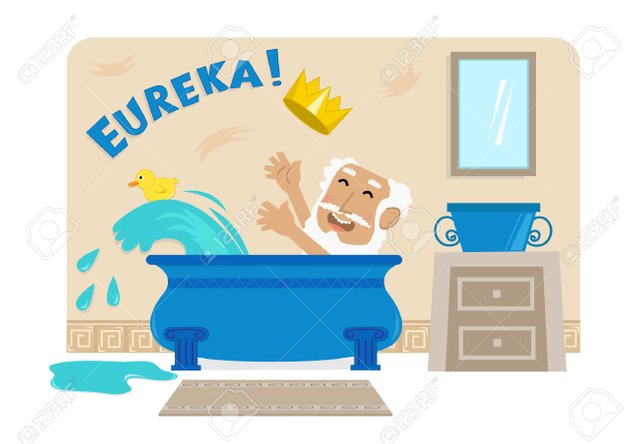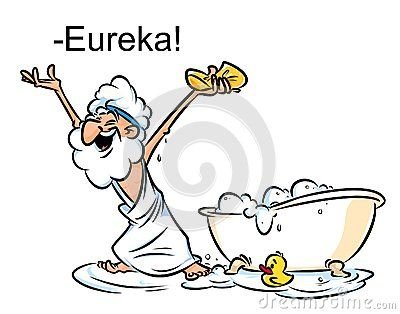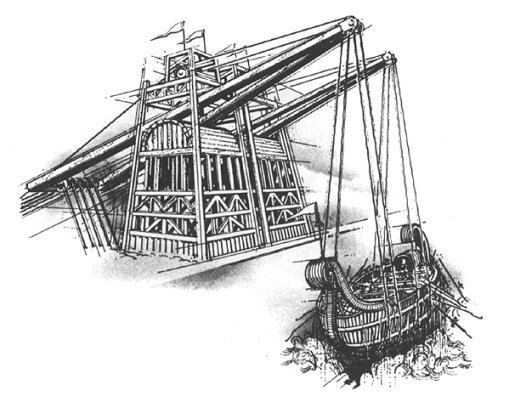Archimedes - The fun tale who every body forgot

For almost a hundred years, the ancient Greek city of Syracuse had been at war with Carthage, and riven by internal strife as successive rulers fought each other for the throne. Till, in 275 BCE, the Syracusan troops, tired of the inefficiencies of their leaders, elected commanders from amongst themselves. One of these was a young general called Hiero.
Now, Hiero had a natural flair and talent for leadership and politics. He managed, through his connections, to enter the city and take over its government, but so smoothly and efficiently, that the citizens of Syracuse, who usually did not approve of soldiers choosing their own commanders, did so in this case. Then, after a great battle in 265 BCE, in which Hiero led the Syracusans to victory against their enemies, the people of Syracuse chose Hiero to be their king.
Hiero was grateful to the gods for his success and good fortune, and to show his gratitude, he decided to place in a certain temple, a golden crown in their honour. The crown was to be shaped like a laurel wreath. Hiero weighed out a precise amount of gold, and appointing a goldsmith, commanded him to fashion out of the gold a wreath worthy of the gods.
the golden crownThe goldsmith did as he had been ordered, and on he appointed day, he delivered to the king an exquisitely wrought crown, shaped, as the king had ordered, like a laurel wreath. The wreath seemed to weight exactly as much as the gold that the king had given the goldsmith. Hiero was pleased, and paid the goldsmith handsomely. The goldsmith, receiving his payment, went away.
Hiero made preparations for the ceremony to place the wreath in the temple that he had chosen. But a few days before the ceremony, he heard rumours that the goldsmith had cheated him, and given him a crown not of pure gold, but of gold that had silver mixed in it. The goldsmith, said the rumours, had replaced some of the gold that Hiero had given him, with an equal weight of silver.
Hiero was furious to learn that he might have been tricked. But he was a fair-minded man and wished to determine the truth before he punished the goldsmith.
If the goldsmith had indeed cheated him and mixed silver into the gold, then the goldsmith would have to be punished, and the crown could no longer be given as an offering to the gods. But if the goldsmith had been honest, then the crown remained what it had been intended to be, a sacred offering, and it would be placed in the temple as planned. So it was important that Hiero find out the truth quickly, before the day fixed for the ceremony, and without damaging the crown in any way.
Hiero believed there was only one man in Syracuse capable of discovering the truth and solving his problem. This was his cousin, Archimedes, a young man of 22, who was already renowned for his work in mathematics, mechanics and physics.

Deep in thought, pondering how best to solve the king’s problem, Archimedes walked to the public baths for his daily bath. Still thinking about the golden crown, he went through the rituals of cleansing and washing, and stepped into a tub of cool water for his final dip. As he began to lower himself into the water, the water in the tub began to spill out over the sides. Curious, Archimedes continued to lower himself slowly into the water, and he noticed that the more his body sank into the water, the more water ran out over the sides of the tub. He realised that he had found the solution to Hiero’s problem.
He was so excited by his discovery that he jumped out of the tub at once, and ran all the way home without remembering to put his clothes on, and shouting ‘Eureka, Eureka!’ – which in Greek means, ‘I have found it! I have found it!’
What Archimedes had found was a method for measuring the volume of an irregularly-shaped object. He realised that an object, when immersed in water, displaced a volume of water equal to its own volume, and that by measuring the volume of the displaced water, the volume of the object could be determined, regardless of the object’s shape. So, he could measure the volume of the crown by measuring the volume of the water spilled from a container filled with water to the brim when the crown was fully dipped in it.
How then, would this realisation help him to answer Hiero’s question – had the goldsmith mixed silver in the golden crown or not? Let us see how Archimedes used his discovery to solve the king’s problem.
In physics, when we speak of the density of an object, we are comparing its mass with its volume, or, in simpler words, considering how heavy it is in relation to its size. For example, iron is denser than cork. So a lump of iron is much heavier than a piece of cork of the same size, or much smaller than a piece of cork of the same weight.
Archimedes knew that gold was denser than silver – so a piece of gold weighing a certain amount would be smaller than a piece of silver weighing the same:
gold silver
Thus, if the goldsmith had stolen some of the gold the king had given him, and replaced it with an equal weight of silver in the crown, then the total volume of the gold+silver crown would be greater than the volume of the original amount of gold.
So now, all that remained for Archimedes to do was to compare the volume of the crown to the volume of the amount of gold that Hiero had given the goldsmith.
The simplest method of determining the volume of the crown would have been to melt it down, shape it into a cube and measure its volume. But Hiero had given strict instructions that the crown was not to be damaged in any way. So how was the volume to be determined? This is where Archimedes’ discovery came in useful.
First, Archimedes took a lump of gold and a lump of silver, each weighing exactly the same as the crown, and filled a large vessel with water to the brim, precisely measuring how much water was contained in the vessel.
gold gold silver
he lowered the lump of silver into the waterHe then gently lowered the lump of silver into it. This caused as much water to spill out over the sides of the vessel as was equal in volume to the lump of silver. Archimedes took the lump of silver out of the water and carefully measured the amount of water left in the vessel, thus arriving at the amount of water that had been displaced by the silver.
he lowered the lump of gold into the waterHe again filled the vessel with water to brim, taking care to fill it with exactly the same amount of water as before. He then lowered the lump of gold into the water, and let the water displaced by it spill out over the sides. Then, doing as he had done with the lump of silver, Archimedes took out the lump of gold from the water, and arrived at the amount of water that had been displaced by the gold.
He found that a smaller quantity of water had been displaced by the gold than the silver, and the difference was equal to the difference in volume between a lump of gold and a lump of silver of the same weight.
He filled the bowl with water to the brim a final time, taking care to fill it with exactly the same amount of water as before. This time he lowered the crown into the water. He knew that if the crown was pure gold, its volume would be the same as that of the lump of gold (which he had made sure weighed the same as the crown), regardless of shape, and that it would displace the same amount of water as the gold. But, if the goldsmith had replaced some of the gold with silver, then the volume of the gold+silver crown would be greater than the volume of the gold, and so the crown would displace more water than the gold.
he lowered the crown into the vessel of water
Archimedes found that the crown did, in fact displace more water than the lump of gold of equal weight. Thus he came to the conclusion that the crown was not pure gold, and that the goldsmith had indeed mixed some silver (or other, lighter metal) into the gold in an attempt to cheat the king.

This story of Archimedes and the golden crown is found in De Architectura or The Ten Books of Architecture, written by the Roman architect Marcus Vitruvius Pollo some time during the first century BCE. This story is not found anywhere among the known works of Archimedes, though in his book, On Floating Bodies, he gives the principle known as Archimedes’ Principle, which states that a body partially or completely immersed in a fluid is buoyed up by a force equal to the weight of the fluid displaced by the body.
The method that Vitruvius says was used by Archimedes, though correct in theory, has been criticised by scientists as too difficult to implement with the amount of accuracy that would be needed to detect a component of silver or other lighter metal in the crown. This is because that the amounts of gold and silver in the case of a crown would be so small that the difference in their volumes, and the consequent difference in the amount of water displaced, would be too small to measure with precision with the measurement methods available to Archimedes.
More than eighteen hundred years after Archimedes is said to have helped King Hiero detect the goldsmith’s fraud, another young man, also twenty-two years old at the time, pondered the same problem. This young man was Galileo Galilei, the Italian mathematician, physicist and astronomer. In 1586, Galileo wrote a short treatise called La Bilancetta, or The Little Balance, in which he expressed his scepticism of Vitruvius’ story and presented his own theory of how Archimedes might actually have detected the goldsmith’s dishonesty. He based his theory on the Archimedes Principle, and on Archimedes’ work on levers.
Galileo’s method is simple, yet precise and detailed, even determining the exact quantity of gold and silver (or a lighter metal) in the alloy. It is very likely that Archimedes detected the goldsmith’s fraud by a method similar to that described by Galileo. While not detailing Galileo’s treatise here, let me give a method, based on what Galileo says, that Archimedes might have used:
Instead of immersing the crown and an equal weight of gold in a vessel filled with water, Archimedes could have suspended the crown from one end of a pair of scales, balancing it with an equal amount of gold on the other end. Once equally balanced, he would have immersed the suspended crown and lump of gold into a vessel of water. Now, since a body immersed in water is buoyed up by a force equal to the weight of the water displayed by the body, the denser body, which has a smaller volume for the same weight, would sink lower in the water than the less dense one.
So, if the crown was pure gold, the scales would continue to balance even when immersed in the water. If the crown was not pure gold, and silver or a lighter metal had been mixed with the gold thus increasing its volume, then the scales would tilt towards the denser gold. And thus it would have been possible for Archimedes to find out quickly and simply, without damaging Hiero’s golden wreath in any way, whether the goldsmith had cheated the king or not.
